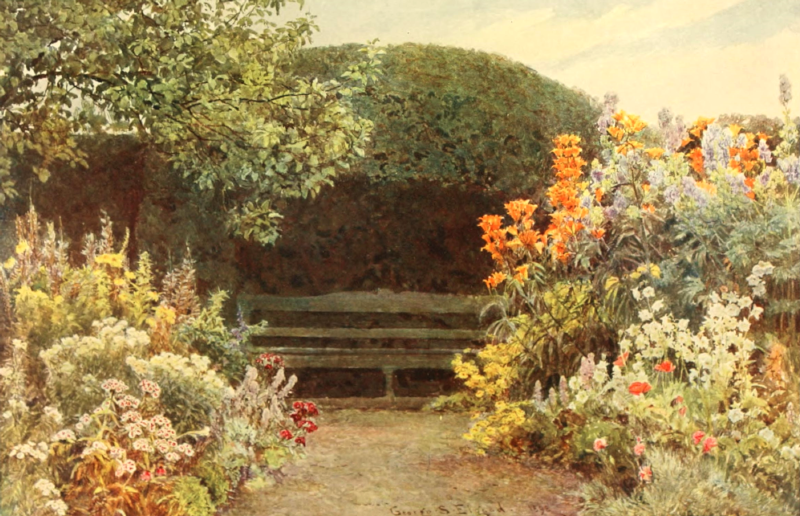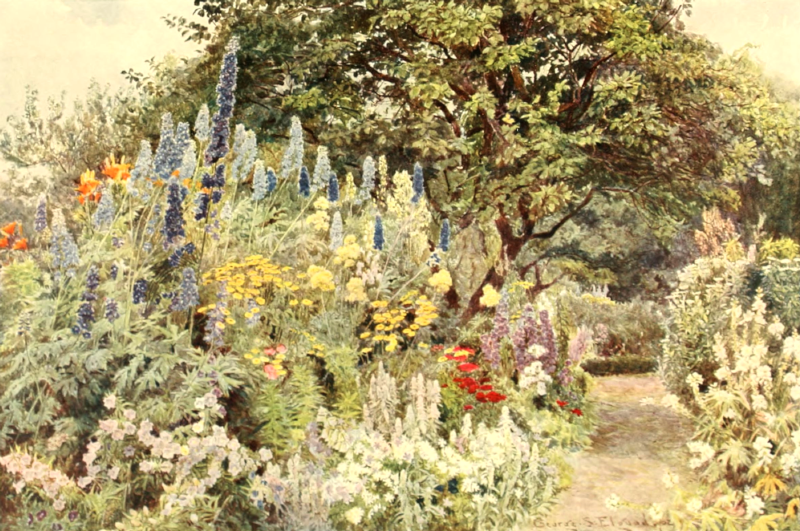| Web
and Book design,
Copyright, Kellscraft Studio 1999-2021 (Return to Web Text-ures) |
 (HOME)
|
|
RAMSCLIFFE It
would seem to be a law that the purest and truest human pleasure in a garden is
attained by means whose ratio is exactly inverse to the scale or degree of the garden's
magnificence. The design, for instance, of a Versailles impresses one with a
sense of ostentatious consciousness of magnitude; out of scale with living men
and women; whose lives could only be adapted to it, as we know they were, by an
existence full of artificial restraints and discomforts; the painful and
arbitrarily imposed conditions of a tyrannical and galling etiquette. So we
think also of our greatest gardens, such as Chatsworth. It is visited by a
large number of people who go to see it as a large expensive place to gape at,
but surely not for the truest love of a garden. So it is with many a large
place; the size and grandeur of the garden may suit the great house as a design;
it may be imposing and costly, it may be beautifully kept, and yet it may lack
all the qualities that are needed for simple pleasure and refreshment. It is
not till we come to some old garden of moderate size that has always been
cherished and has never been radically altered, that the true message of the
garden can be received and read; and it is from thence downward in the scale of
grandeur that we find those gardens that are the happiest and best of all for
true delight and close companionship; the simple borders of hardy flowers,
planted and tended with constant watchfulness and loving care by the owner's
own hands. 
RAMSCLIFFE: ORANGE LILIES & MONKSHOOD From the picture in the possession of Mr. C E. Freeling How
well an artist knows the value of grey-leaved plants, and their use in
pictorial gardening in the way of giving colour-value by close companionship,
to tender pinks and lilacs, and, above all, to whites! A patch of white bloom
is often too hard and sudden and inharmonious to satisfy the trained eye, but
led up to and softened and sweetened by masses of neighbouring tender grey it
takes its proper place and comes to its right strength in the well-ordered scheme.
Lavender, Lavender-cotton (Santolina), Catmint, Pinks and Carnations,
and the Woolly Woundwort (Stachys) with some other plants of hoary
foliage, do this good work. In this garden the Woundwort, there known by its
old Midland name of "Our Saviour's Blanket," throws up its grey-pink heads
of bloom from a thick carpet of rather large leaves, silvery soft with their
thick coating of long white down. Here a groundwork of it leads to the group of
white Peach-leaved Bell-flower on the right and to the tall white Gnaphalium, a
plant of kindred woolliness, on the left, while the precious grey quality runs
through the left-hand flower-group by means of the downy-coated pods of the
earlier-blooming Lupins, purposely left among the later flowers for this and
for their handsome form. How
finely the Orange Lilies tell against the background of the holly hedge, at the
path-end cut into an arbour, may well be seen in the picture, and how kindly
and gracefully the Greengage Plum-tree bends over and plays its appointed part.
Such
a flower border makes many a picture in the hands of a garden-artist. His
knowledge of the plants, their colours, seasons, habits and stature, enables
him to use them as he uses the colours on his palette. How
grandly the tall Delphiniums grow in this strong soil. A little of the colour
has been lost owing to technical difficulties of reproduction, for the blue is
purer and stronger in effect both in the original picture and in nature than is
here shown. They are grouped, as blue flowers need, with contrasts of yellow
and orange; with yellow Daisies and the feathery Meadow-rue (Thalictrum),
and the tall yellow Aconite and nearly white Campanulas, woolly Stachys and
purple Bell-flowers beyond. Only one small patch of brighter colour, the
scarlet of Lychnis chalcedonica, is allowed here. On the other side is the
loose-growing and always pictorial white Mallow (Sidalcea Candida), taking some
weeks to produce its crop of flowers that, like Foxgloves and most of the
flowers of the tall-spiked habit of growth, begin to bloom below, following
upward till they finish at the top. Some
sort of garden knowledge is so generally professed in these days, and so much
more gardening of the better kind is being attempted, that people are gradually
learning the advantage of planting in good groups of one thing at a time. The
older way of putting one each of the same plant at regular intervals along a
border — like buttons on a waistcoat — is now no longer tolerated, but a great
deal has yet to be learnt. Even planting in bold groups, however good the
plants, will be ineffective if not absolutely unfortunate, if relationships of
colouring are not understood. The safest plan is to plant in harmonies more or
less graduated as to the warm colours, such as full yellow with orange and
scarlet, and to plant blues with contrasts of yellows and any white flowers.
Then delightful effects may be obtained with masses of grey foliage, such as
Lavender, Lavender-cotton, and Stachys, and white Pink, with flowers that have colourings
of tender pink, white, lilac and purple. To acquire a colour eye is an
education in itself, founded on the needful natural aptitude, a gift that is
denied to some people even if they are not actually colour-blind, but it is a
precious possession where it occurs, and the better when it has been so well
trained that the eye is enabled to appreciate the utmost refinements of colour-values,
and when this education has been carried to the point necessary for the artist,
of justly estimating the colour as it appears to be. This is the most
difficult thing to learn; to see colour as it is, is quite easy; any one not
colour-blind can do this; but to see it as it appears to be needs to be learnt,
for upon this acquired proficiency depends the power of the artist to interpret
the colours of objects and to represent them in their right relation to each
other. There
is another good double flower-border in this pleasant garden. In the sunny
month of August the fine Summer Daisies (Chrysanthemum maximum). Phloxes and
Lavender are in beauty, and some bloom remains upon the climbing Roses. The
Box-edging, stout and strong, can withstand the temporary encroachments of some
of the border flowers, for in such a garden, rule is relaxed whenever such
latitude tends to beauty. Here and there, where the little edging shrub showed
signs of unusual vigour, it has been allowed to grow up on the understanding that
it shall submit to the shears, which clip it into rounded ball-shapes of two
sizes, one upon another, like loaves of bread. A
garden like this, of moderate size, and needing no troublesome accessories of
glasshouses, or even frames, and very little outside labour, is probably the
very happiest possession of its kind. As the seasons succeed each other new
pictures of flower beauty are revealed in constant succession. After the day's
work in the best of the daylight is over, its owner turns to it for pleasant
labour or any such tending as it may need. Every group of plants meets him with
a friendly face, for each one was planted by his own hands. His watchful eye
observes where anything is amiss and the needful aid is immediately given.  RAMSCLIFFE: LARKSPUR From the picture in the possession of Miss Kensit Such
a garden it is that fulfils its highest purpose; that giving of the pleasure —
the rich reward of the loving toil and care that have gone to its making; every
plant or group in it doing its appointed work in its due season — that giving
of "sweet solace" according to the well-fitting wording of our
far-away ancestors. And when the day's work is done, and the light just begins to fail, no one knows better than the artist that then is the best moment in the garden — when the colours acquire a wonderful richness of "subdued splendour" such as is unmatched throughout the lighter hours of the long summer day. Then it is that the flowers of delicate texture that have grown faint in the full heat, raise their heads and rejoice; that the tall evening Primrose opens its pale wide petals and gives off its faint perfume; that the little lilac cross-flowers of the night-scented Stock open out and show their modest prettiness and pour forth their enchanting fragrance. This early evening hour is indeed the best of all; the hour of loveliest sight, of sweetest scent, of best earthly rest and fullest refreshment of body and spirit. |